A RFID-Integrated Framework for Tag Anti-Collision in UAV-Aided VANETs
Abstract
:1. Introduction
1.1. Background and Motivation
1.2. Related Works
1.2.1. RFID-Integrated UAV-Aided Networks
1.2.2. RFID Tag Anti-Collision Schemes
1.2.3. RFID System Security
1.2.4. Synthesis
1.3. Contributions
- We propose an RFID-integrated framework in UAV-aided VANETs to provide reliable services for vehicles. Specifically, we adopt the flexible deployable UAV as the reader to identify passive tags on vehicles. On this basis, we propose a multifrequency tag identification method to improve the throughput and reduce the collision time slot.
- We devise a tag grouping method based on adaptive power control for the reader, which can dynamically match the optimal frame length. Based on the above matching results, we introduce a tag estimation method using an optimal weight to improve the accuracy of tag estimation. In addition, we analyze the security capacity and security outage probability (SOP) of our proposed network framework.
- We present extensive simulation results to evaluate the performance of the proposed tag anti-collision scheme. From the simulation results, we analyze and discuss the impact of different frequency numbers and frame lengths on the network performance. Compared to current schemes, the proposed tag anti-collision scheme achieves significant superiority in terms of the throughput and identification time slots.
1.4. Organization
2. System Model
2.1. Network Model
2.2. Tags Collision Model

3. Tag Anti-Collision Scheme
3.1. Multifrequency Tags Identification
3.2. Tags Grouping
3.3. Tags Estimation
3.4. Flowchart of Our Scheme
3.5. Security Performance Analysis
3.5.1. Security Capacity
3.5.2. Security Outage Probability (SOP)
4. Simulation Experiments
4.1. Simulation Parameters
4.2. Simulation Results
5. Conclusions
Author Contributions
Funding
Institutional Review Board Statement
Informed Consent Statement
Data Availability Statement
Conflicts of Interest
References
- Feroz, S.; Abu Dabous, S. UAV-Based Remote Sensing Applications for Bridge Condition Assessment. Remote Sens. 2021, 13, 1809. [Google Scholar] [CrossRef]
- Say, S.; Inata, H.; Liu, J.; Shimamoto, S. Priority-Based Data Gathering Framework in UAV-Assisted Wireless Sensor Networks. IEEE Sens. J. 2016, 16, 5785–5794. [Google Scholar] [CrossRef]
- Huang, F.; Zhang, Y.; Wang, Z.; Deng, X. A Novel Conflict Management Method Based on Uncertainty of Evidence and Reinforcement Learning for Multi-Sensor Information Fusion. Entropy 2021, 23, 1222. [Google Scholar] [CrossRef] [PubMed]
- Wang, D.; He, Y.; Yu, K.; Srivastava, G.; Nie, L.; Zhang, R. Delay Sensitive Secure NOMA Transmission for Hierarchical HAP-LAP Medical-care IoT Networks. IEEE Trans. Ind. Informat. 2021. to be published. [Google Scholar] [CrossRef]
- He, Y.; Zhai, D.; Jiang, Y.; Zhang, R. Relay Selection for UAV-assisted Urban Vehicular Ad Hoc Networks. IEEE Wirel. Commun. Lett. 2020, 9, 1379–1383. [Google Scholar] [CrossRef]
- Jobaer, S.; Zhang, Y.; Iqbal Hussain, M.A.; Ahmed, F. UAV-Assisted Hybrid Scheme for Urban Road Safety Based on VANETs. Electronics 2020, 9, 1499. [Google Scholar] [CrossRef]
- Aggarwal, S.; Kumar, N.; Tanwar, S. Blockchain-Envisioned UAV Communication Using 6G Networks: Open Issues, Use Cases, and Future Directions. IEEE Internet Things J. 2021, 8, 5416–5441. [Google Scholar] [CrossRef]
- Afrashteh, M.; Babaie, S. A Route Segmented Broadcast Protocol Based on RFID for Emergency Message Dissemination in Vehicular Ad-Hoc Networks. IEEE Trans. Veh. Technol. 2020, 69, 16017–16026. [Google Scholar] [CrossRef]
- Saxl, G.; Görtschacher, L.; Ussmueller, T.; Grosinger, J. Software-Defined RFID Readers: Wireless Reader Testbeds Exploiting Software-Defined Radios for Enhancements in UHF RFID Systems. IEEE Microw. Mag. 2021, 22, 46–56. [Google Scholar] [CrossRef]
- Zhang, W.; Lin, B.; Gao, C.; Yan, Q.; Li, S.; Li, W. Optimal Placement in RFID-Integrated VANETs for Intelligent Transportation System. In Proceedings of the 2018 IEEE International Conference on RFID Technology & Application (RFID-TA), Macao, China, 26–28 September 2018; pp. 1–6. [Google Scholar]
- Buffi, A.; Nepa, P.; Cioni, R. SARFID on drone: Drone-based UHF-RFID tag localization. In Proceedings of the 2017 IEEE International Conference on RFID Technology & Application (RFID-TA), Warsaw, Poland, 20–22 September 2017; pp. 40–44. [Google Scholar]
- Longhi, M.; Marrocco, G. Flying Sensors: Merging Nano-UAV with Radiofrequency Identification. In Proceedings of the 2017 IEEE International Conference on RFID Technology & Application (RFID-TA), Warsaw, Poland, 20–22 September 2017; pp. 164–168. [Google Scholar]
- Greco, G.; Lucianaz, C.; Bertoldo, S.; Allegretti, M. A Solution for Monitoring Operations in Harsh Environment: A RFID Reader for Small UAV. In Proceedings of the 2015 International Conference on Electromagnetics in Advanced Applications (ICEAA), Turin, Italy, 7–11 September 2015; pp. 859–862. [Google Scholar]
- He, Y.; Zhang, R.; Li, B.; Wang, D. An Anti-Collision Protocol Based on UAV for Internet of Things. In Proceedings of the IEEE 11th International Conference on Wireless Communications and Signal Processing (WCSP), Xi’an, China, 23–25 October 2019; pp. 1–6. [Google Scholar]
- Buffi, A.; Motroni, A.; Nepa, P.; Tellini, B.; Cioni, R. A SAR-Based Measurement Method for Passive-Tag Positioning with a Flying UHF-RFID Reader. IEEE Trans. Instrum. Meas. 2019, 68, 845–853. [Google Scholar] [CrossRef]
- Hrúz, M.; Bugaj, M.; Novák, A.; Kandera, B.; Badánik, B. The Use of UAV with Infrared Camera and RFID for Airframe Condition Monitoring. Appl. Sci. 2021, 11, 3737. [Google Scholar] [CrossRef]
- Won, D.; Park, M.; Chi, S. Construction Resource Localization Based on UAV-RFID Platform Using Machine Learning Algorithm. In Proceedings of the 2018 IEEE International Conference on Industrial Engineering and Engineering Management (IEEM), Bangkok, Thailand, 16–19 December 2018; pp. 1086–1090. [Google Scholar]
- Zhang, J.; Yu, Z.; Mao, S.; Periaswamy, S.C.G.; Patton, J.; Xia, X. IADRL: Imitation Augmented Deep Reinforcement Learning Enabled UGV-UAV Coalition for Tasking in Complex Environments. IEEE Access 2020, 8, 102335–102347. [Google Scholar] [CrossRef]
- Orgeira-Crespo, P.; Ulloa, C.; Rey-Gonzalez, G.; Pérez García, J.A. Methodology for Indoor Positioning and Landing of an Unmanned Aerial Vehicle in a Smart Manufacturing Plant for Light Part Delivery. Electronics 2020, 9, 1680. [Google Scholar] [CrossRef]
- Won, D.; Chi, S.; Park, M. UAV-RFID Integration for Construction Resource Localization. KSCE J. Civ. Eng. 2020, 24, 1683–1695. [Google Scholar] [CrossRef]
- Li, C.; Tanghe, E.; Plets, D.; Suanet, P.; Hoebeke, J.; Poorter, E.D.; Joseph, W. ReLoc: Hybrid RSSI- and Phase-Based Relative UHF-RFID Tag Localization With COTS Devices. IEEE Trans. Instrum. Meas. 2020, 69, 8613–8627. [Google Scholar] [CrossRef]
- Rahman, M.M.; McDermid, G.J.; Strack, M.; Lovitt, J. A New Method to Map Groundwater Table in Peatlands Using Unmanned Aerial Vehicles. Remote Sens. 2017, 9, 1057. [Google Scholar] [CrossRef] [Green Version]
- Casati, G.; Longhi, M.; Latini, D.; Carbone, F.; Amendola, S.; Frate, F.D.; Schiavon, G.; Marrocco, G. The Interrogation Footprint of RFID-UAV: Electromagnetic Modeling and Experimentations. IEEE J. Radio Freq. Identificat. 2017, 1, 155–162. [Google Scholar] [CrossRef]
- Tan, X.; Wang, H.; Fu, L.; Wang, J.; Min, H.; Engels, D.W. Collision Detection and Signal Recovery for UHF RFID Systems. IEEE Trans. Autom. Sci. Eng. 2018, 15, 239–250. [Google Scholar]
- Samsami, M.M.; Yasrebi, N. Novel RFID Anti-Collision Algorithm Based on the Monte-Carlo Query Tree Search. Wirel. Netw. 2021, 27, 621–634. [Google Scholar] [CrossRef]
- Jia, X.; Bolic, M.; Feng, Y.; Gu, Y. An Efficient Dynamic Anti-Collision Protocol for Mobile RFID Tags Identification. IEEE Commun. Lett. 2019, 23, 620–623. [Google Scholar] [CrossRef]
- Gao, Y.; Gao, X.; Yang, X.; Liu, J.; Chen, G. An Efficient Ring-Based Metadata Management Policy for Large-Scale Distributed File Systems. IEEE Trans. Parallel Distrib. Syst. 2019, 30, 1962–1974. [Google Scholar] [CrossRef]
- Huang, Z.; Xu, R.; Chu, C.; Li, Z.; Qiu, Y.; Li, J.; Ma, Y.; Wen, G. A Novel Cross Layer Anti-Collision Algorithm for Slotted ALOHA-Based UHF RFID Systems. IEEE Access 2019, 7, 36207–36217. [Google Scholar] [CrossRef]
- Benedetti, D.; Maselli, G.; Petrioli, C.; Piva, M. The Impact of External Interference on RFID Anti-Collision Protocols. IEEE Netw. Lett. 2019, 1, 76–79. [Google Scholar] [CrossRef]
- Pakkathillam, J.K.; Kanagasabai, M.; Alsath, M.G.N. Compact Multiservice UHF RFID Reader Antenna for Near-Field and Far-Field Operations. IEEE Antennas Wirel. Propag. Lett. 2017, 16, 149–152. [Google Scholar] [CrossRef]
- Prakash, A.; Anand, R.; Chandra, B.M. Forward Search Approach Using Power Search Algorithm (FSA-PSA) to Solve Dynamic Economic Load Dispatch problems. In Proceedings of the 2019 5th International Conference on Advanced Computing & Communication Systems (ICACCS), Coimbatore, India, 15–16 March 2019; pp. 1139–1142. [Google Scholar]
- Bae, Y.H. Modeling Timely-Delivery Ratio of Slotted Aloha With Energy Harvesting. IEEE Commun. Lett. 2017, 21, 1823–1826. [Google Scholar] [CrossRef]
- Khalil, G.; Doss, R.; Chowdhury, M. A New Secure RFID Anti-Counterfeiting and Anti-Theft Scheme for Merchandise. J. Sens. Actuator Netw. 2020, 9, 16. [Google Scholar] [CrossRef] [Green Version]
- Liu, H.; Ning, H.; Zhang, Y.; He, D.; Xiong, Q.; Yang, L.T. Grouping-proofs-based Authentication Protocol for Distributed RFID Systems. IEEE Trans. Parallel Distrib. Syst. 2013, 24, 1321–1330. [Google Scholar] [CrossRef]
- Sun, D.; Mu, Y. Security of Grouping-proof Authentication Protocol for Distributed RFID Systems. IEEE Wirel. Commun. Lett. 2018, 7, 254–257. [Google Scholar] [CrossRef]
- Hosseinzadeh, M.; Lansky, J.; Rahmani, A.M.; Trinh, C.; Safkhani, M.; Bagheri, N. Huynh, B. A New Strong Adversary Model for RFID Authentication Protocols. IEEE Access 2020, 8, 125029–125045. [Google Scholar] [CrossRef]
- He, Y.; Zhai, D.; Huang, F.; Wang, D.; Tang, X.; Zhang, R. Joint Task Offloading, Resource Allocation, and Security Assurance for Mobile Edge Computing-Enabled UAV-Assisted VANETs. Remote Sens. 2021, 13, 1547. [Google Scholar] [CrossRef]
- Fan, K.; Jiang, W.; Li, H.; Yang, Y. Lightweight RFID Protocol for Medical Privacy Protection in IoT. IEEE Trans. Ind. Informat. 2018, 14, 1656–1665. [Google Scholar] [CrossRef]
- Sun, H.; Ting, W. ISO/IEC WD 29167–6 Information Technology—Automatic Identification and Data Caputre Techniques—Part 6: Air Interface for Security Services and File Management for RFID at 860–960 MHz; Internation Organization for Standardization: Geneva, Switzerland, 2010. [Google Scholar]
- Arjona, L.; Landaluce, H.; Perallos, A.; Onieva, E. Dynamic Frame Update Policy for UHF RFID Sensor Tag Collisions. Sensors 2020, 20, 2696. [Google Scholar] [CrossRef] [PubMed]
- Chen, Y.H.; Chen, Y.A.; Huang, S.R. A Mobility Aware Binary Tree Algorithm to Resolve RFID Jam and Bottleneck Problems in a Next Generation Specimen Management System. Micromachines 2020, 11, 755. [Google Scholar] [CrossRef] [PubMed]
- Jiang, Z.; Li, B.; Yang, M.; Yan, Z. LC-DFSA: Low Complexity Dynamic Frame Slotted Aloha Anti-Collision Algorithm for RFID System. Sensors 2020, 20, 228. [Google Scholar] [CrossRef] [PubMed] [Green Version]
- Jiang, Y.; Zhang, R.; Cheng, W.; Li, B. A Tag Distribution Distance Based Collision Avoidance Algorithm in RFID Systems. J. Northwestern Polytech. Univ. 2016, 34, 250–255. [Google Scholar]
- Su, J.; Sheng, Z.; Liu, A.X.; Han, Y.; Chen, Y. A Group-Based Binary Splitting Algorithm for UHF RFID Anti-Collision Systems. IEEE Trans. Commun. 2020, 68, 998–1012. [Google Scholar] [CrossRef] [Green Version]
- Wang, D.; Zhou, F.; Leung, V.C.M. Primary Privacy Preserving With Joint Wireless Power and Information Transfer for Cognitive Radio Networks. IEEE Trans. Cognit. Commun. Netw. 2020, 6, 683–693. [Google Scholar] [CrossRef]
- Sheng, J.; Fan, Y.; Xia, M. Physical Layer Security Performance Analysis for Wireless Sensor Network. Comput. Eng. Appl. 2021, 57, 91–95. [Google Scholar]
- Wang, D.; Ren, P.; Cheng, J.; Wang, Y. Achieving Full Secrecy Rate With Energy-Efficient Transmission Control. IEEE Trans. Commun. 2017, 65, 5386–5400. [Google Scholar] [CrossRef]
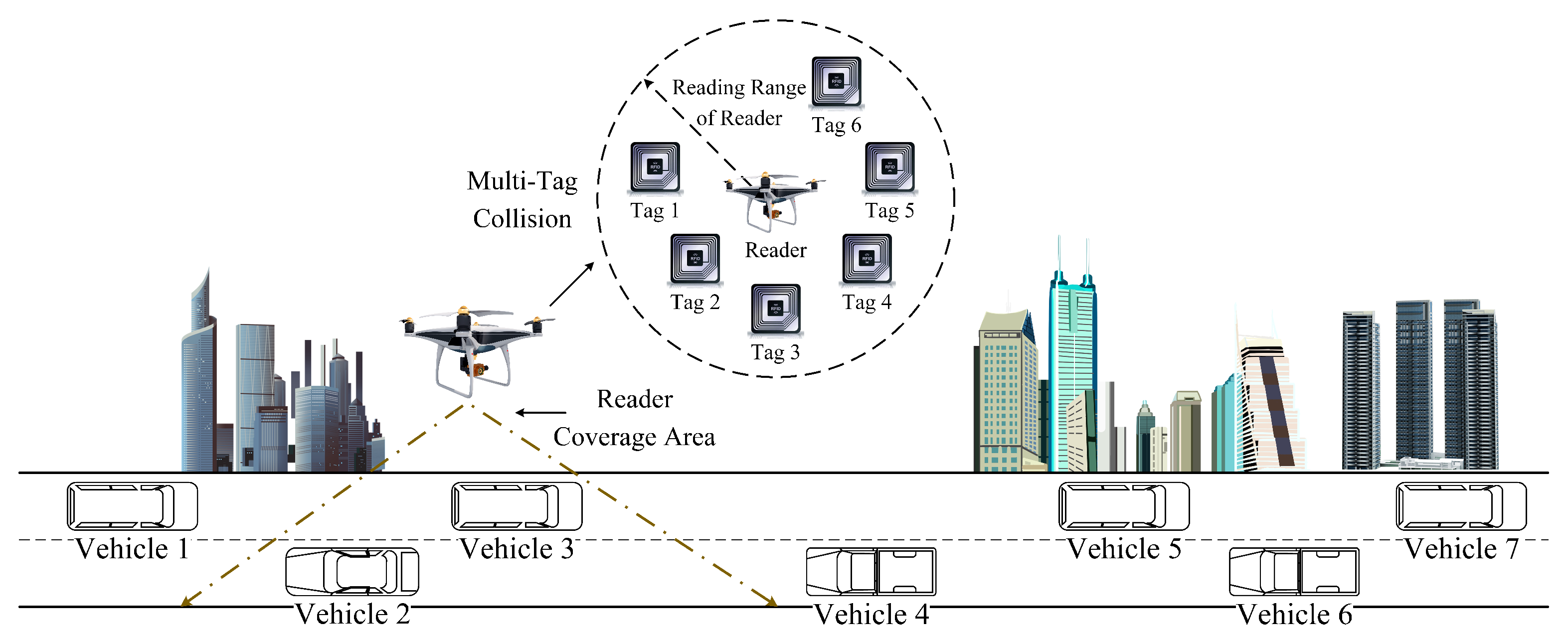
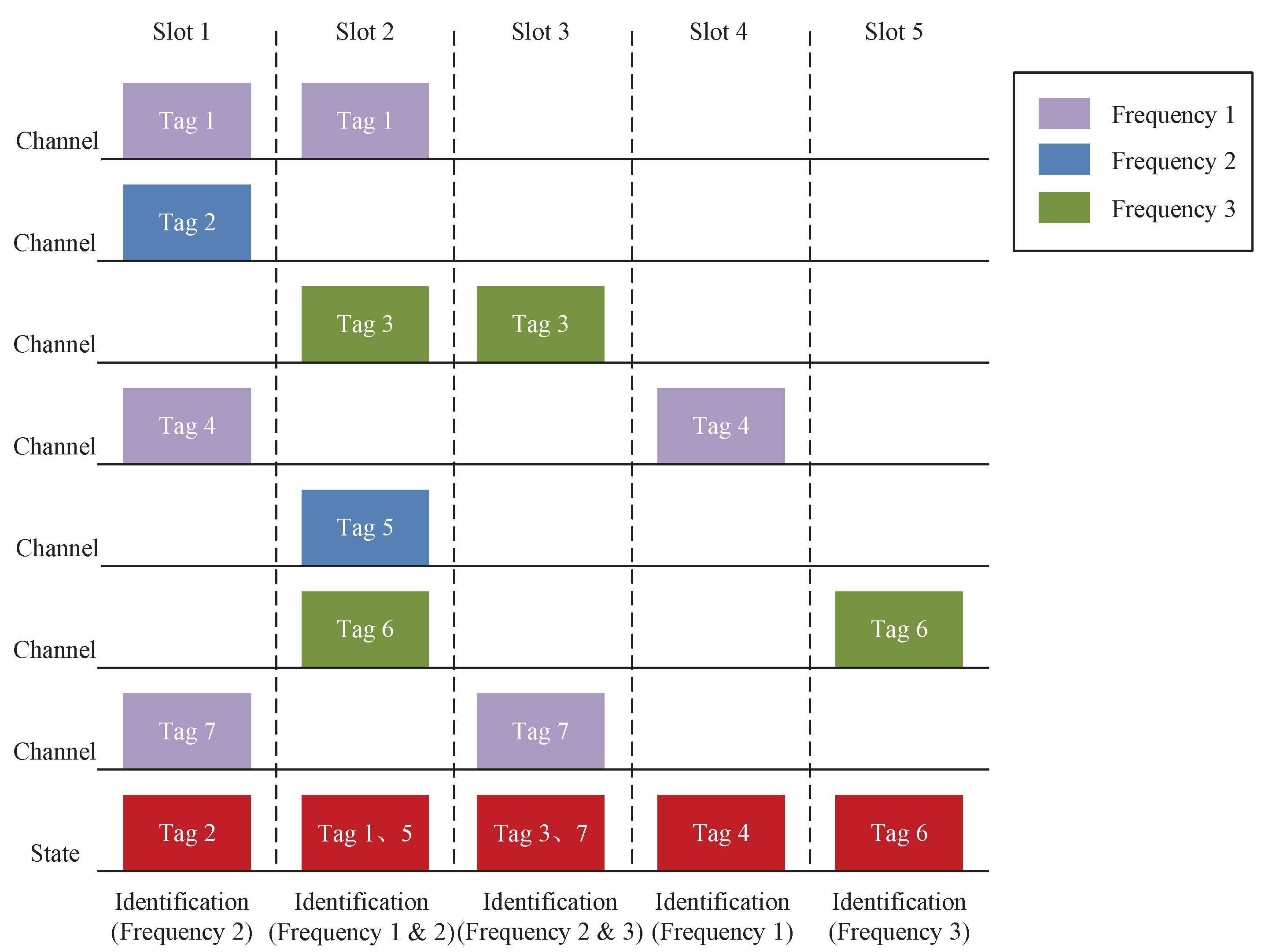

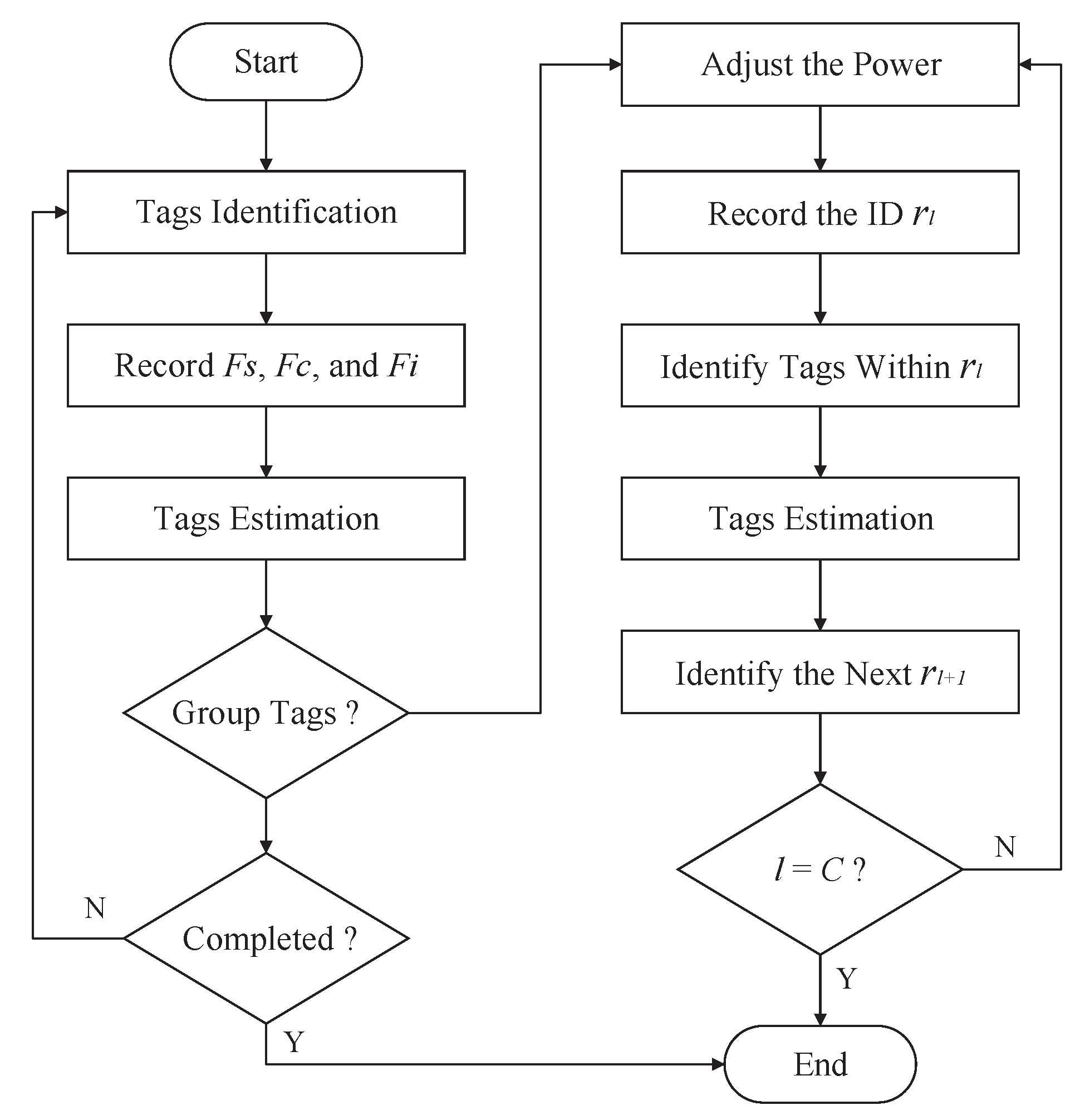
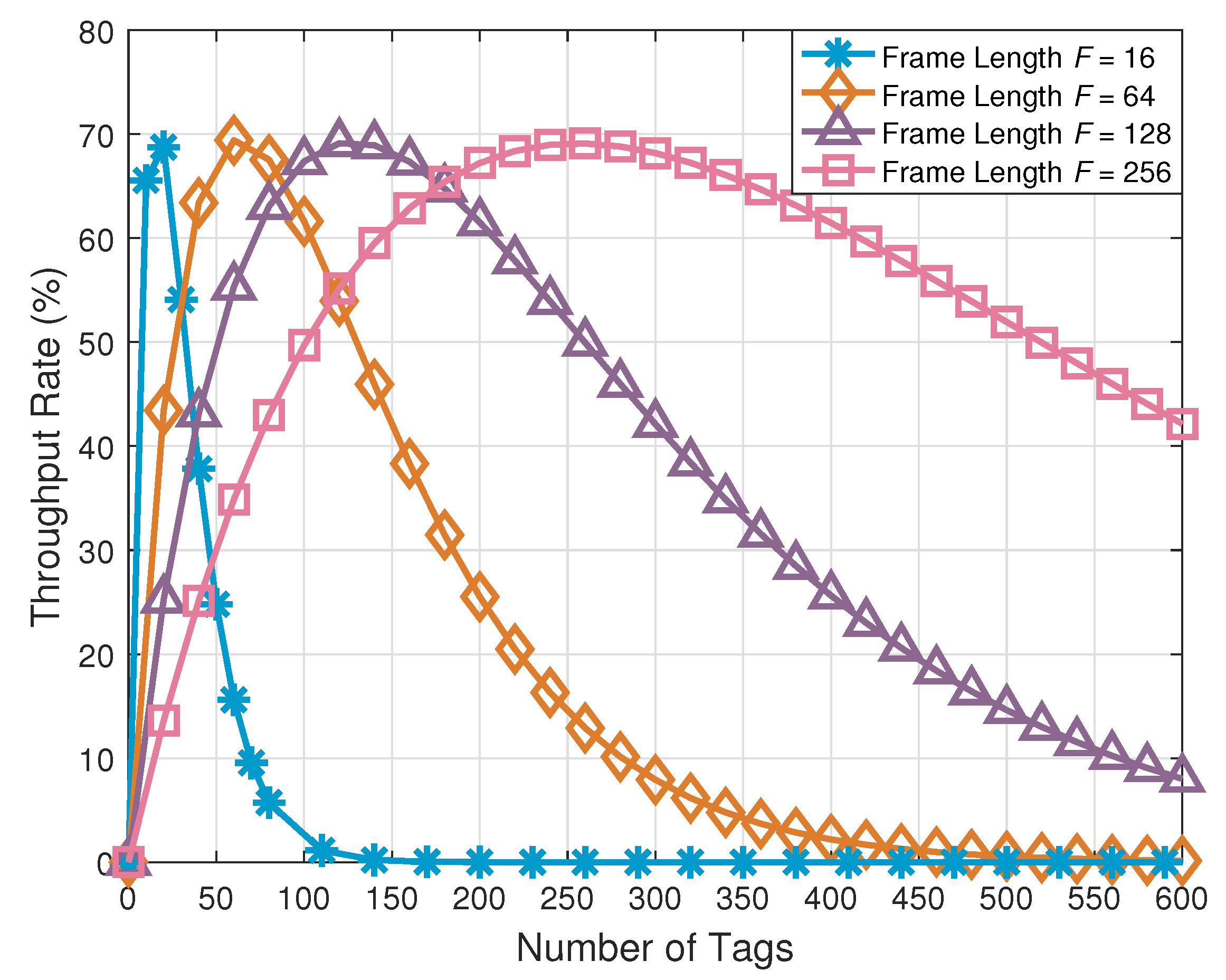
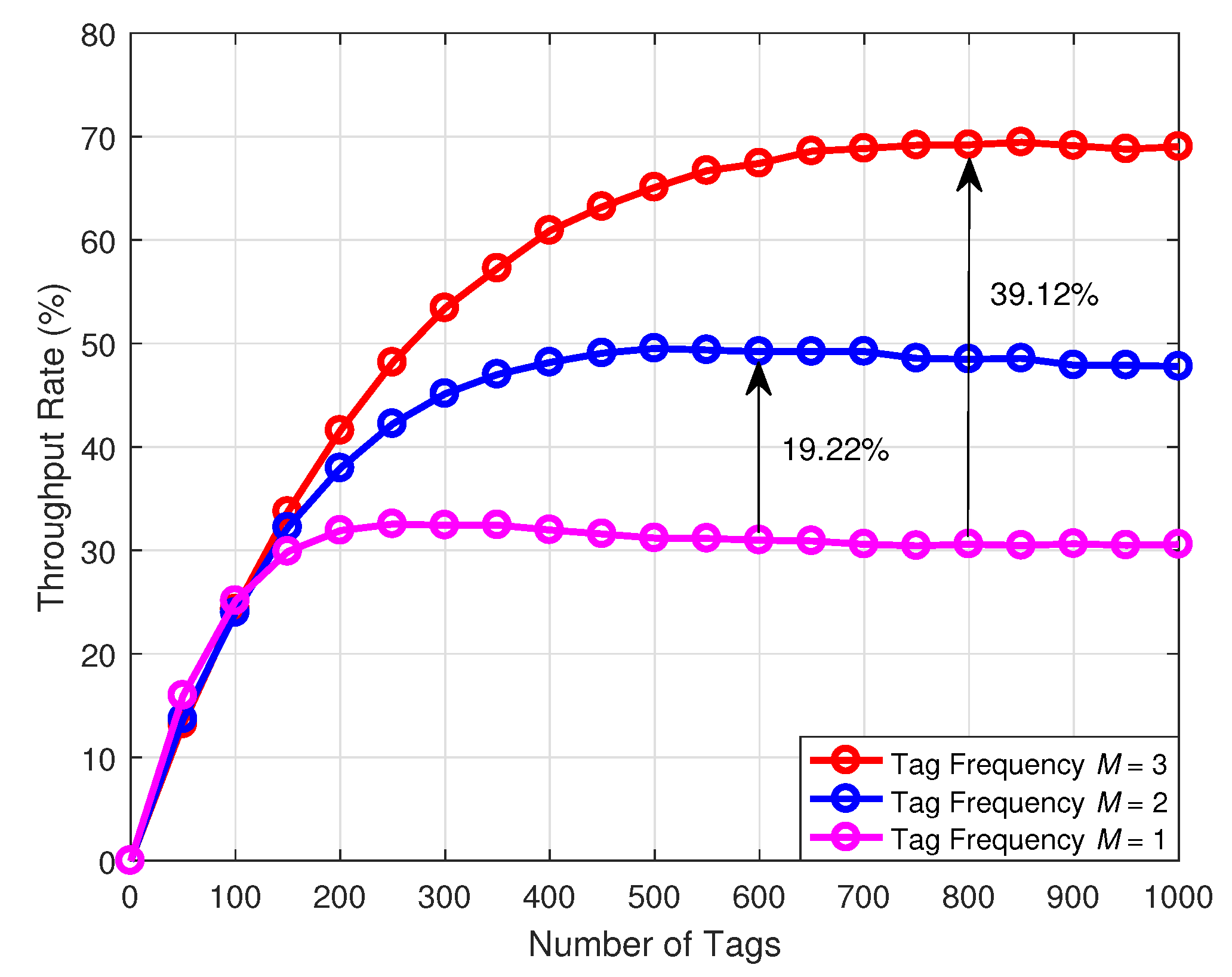
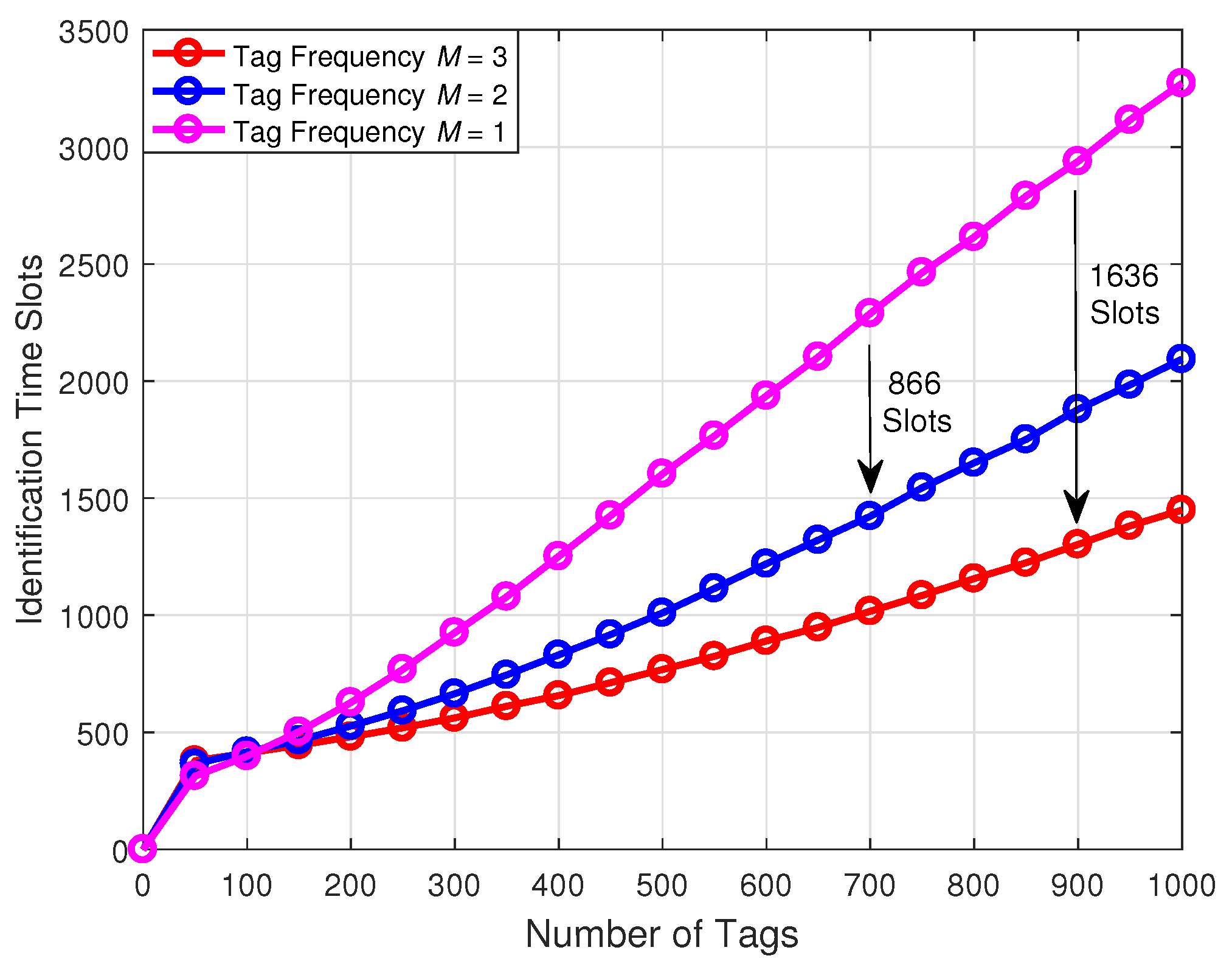
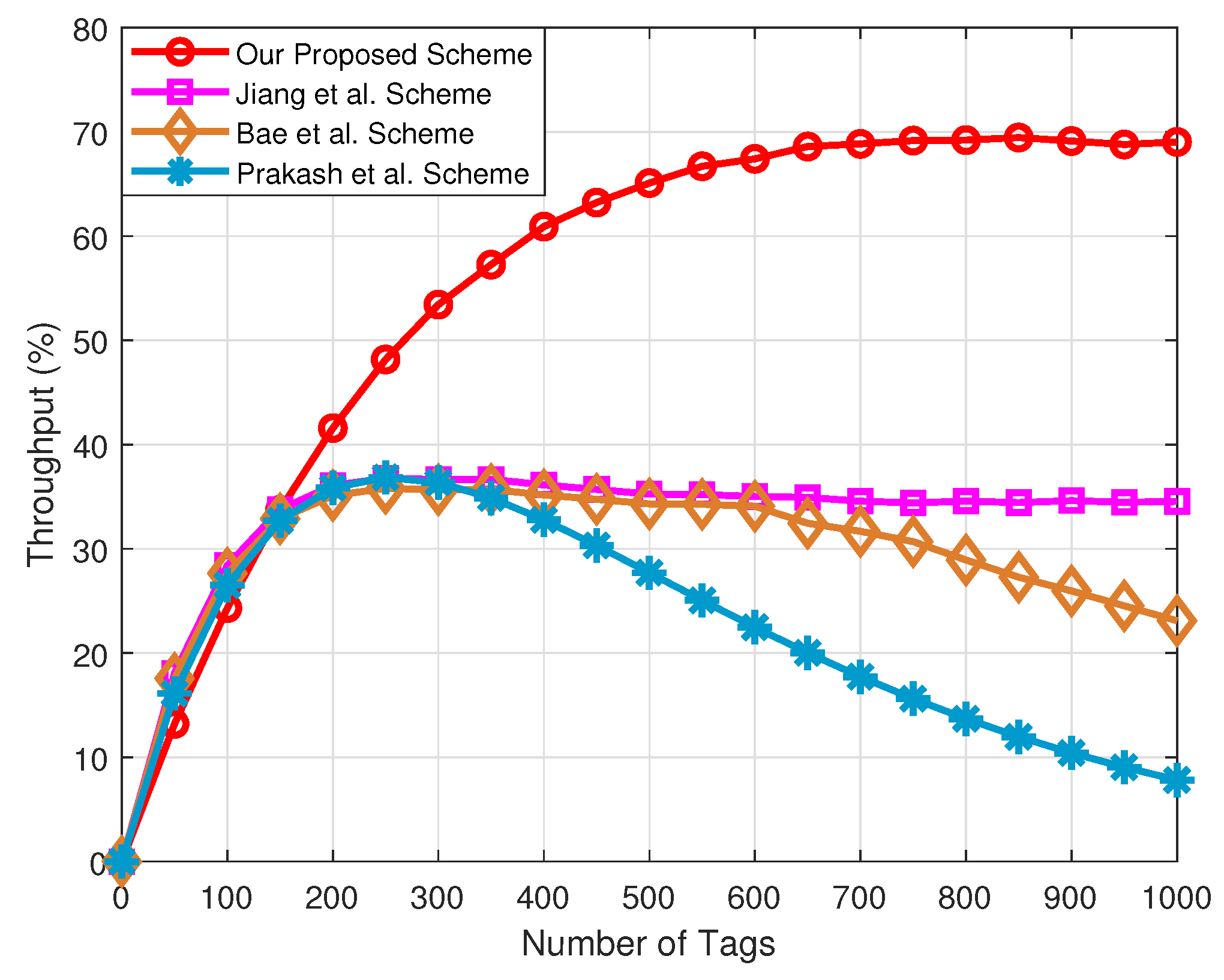

| Country | Frequency Bands | Country | Frequency Bands |
|---|---|---|---|
| China | 840–845 MHz | New Zealand | 864–868 MHz |
| 865–868 MHz | 923–925 MHz | ||
| 920–925 MHz | Korea | 910–914 MHz | |
| 925–928 MHz | Europe | 865–868 MHz | |
| Australian | 918–926 MHz | North America | 902–928 MHz |
| India | 865–867 MHz | Japan | 952–954 MHz |
| Estimation Formulas | Estimation Methods |
|---|---|
| Low Bound method | |
| Schoute method | |
| Vogt method | |
| Two-factor estimation method | |
| 3D estimation method |
| Parameter | Value |
|---|---|
| Reader/Tag Frequency 1 | 840–845 MHz |
| Reader/Tag Frequency 2 | 865–868 MHz |
| Reader/Tag Frequency 3 | 920–925 MHz |
| Reader Power | 33 dBm |
| Number of Tags | [0, 1000] |
| Frame Length | [4, 256] |
| Number of tag’s estimation methods | 5 |
| Simulation Times | 5000 |
| Number of Tags | Frame Length | Number of Groups | Number of Tags | Frame Length | Number of Groups |
|---|---|---|---|---|---|
| 1∼5 | 4 | 1 | 89∼177 | 128 | 1 |
| 6∼11 | 8 | 1 | 178∼354 | 256 | 1 |
| 12∼22 | 16 | 1 | 355∼708 | 256 | 2 |
| 23∼44 | 32 | 1 | 709∼1416 | 256 | 4 |
| 45∼88 | 64 | 1 | 1417∼2833 | 256 | 8 |
| ...... | |||||
Publisher’s Note: MDPI stays neutral with regard to jurisdictional claims in published maps and institutional affiliations. |
© 2021 by the authors. Licensee MDPI, Basel, Switzerland. This article is an open access article distributed under the terms and conditions of the Creative Commons Attribution (CC BY) license (https://creativecommons.org/licenses/by/4.0/).
Share and Cite
He, Y.; Wang, D.; Huang, F.; Zhang, Y.; Zhang, R.; Yan, X. A RFID-Integrated Framework for Tag Anti-Collision in UAV-Aided VANETs. Remote Sens. 2021, 13, 4500. https://doi.org/10.3390/rs13224500
He Y, Wang D, Huang F, Zhang Y, Zhang R, Yan X. A RFID-Integrated Framework for Tag Anti-Collision in UAV-Aided VANETs. Remote Sensing. 2021; 13(22):4500. https://doi.org/10.3390/rs13224500
Chicago/Turabian StyleHe, Yixin, Dawei Wang, Fanghui Huang, Yufei Zhang, Ruonan Zhang, and Xiaohong Yan. 2021. "A RFID-Integrated Framework for Tag Anti-Collision in UAV-Aided VANETs" Remote Sensing 13, no. 22: 4500. https://doi.org/10.3390/rs13224500
APA StyleHe, Y., Wang, D., Huang, F., Zhang, Y., Zhang, R., & Yan, X. (2021). A RFID-Integrated Framework for Tag Anti-Collision in UAV-Aided VANETs. Remote Sensing, 13(22), 4500. https://doi.org/10.3390/rs13224500










